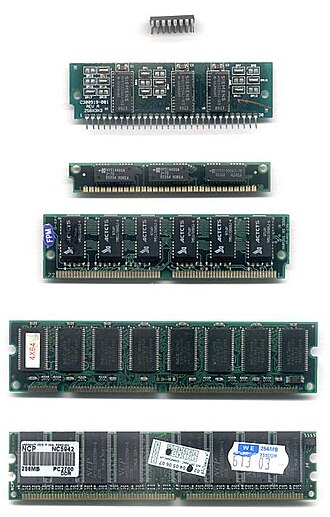Difference between revisions of "AY Honors/Computers/RAM"
From Pathfinder Wiki
m (1 revision: Second Attempt) |
m (W126jep moved page Adventist Youth Honors Answer Book/Computers/RAM to AY Honors/Computers/RAM without leaving a redirect) |
||
| (2 intermediate revisions by 2 users not shown) | |||
| Line 1: | Line 1: | ||
[[Image:RAM n.jpg|thumb|Different RAM types. From top to bottom: DIP, SIPP, SIMM 30 pin, SIMM 72 pin, DIMM (168-pin), DDR DIMM (184-pin).]] | [[Image:RAM n.jpg|thumb|Different RAM types. From top to bottom: DIP, SIPP, SIMM 30 pin, SIMM 72 pin, DIMM (168-pin), DDR DIMM (184-pin).]] | ||
| − | RAM is an acronym that stands for Random Access Memory. | + | RAM is an acronym that stands for Random Access Memory. "Random access" means that the contents of the memory can be accessed in any random order. The term was originally coined to differentiate it from serial memory (such as data stored on a magnetic tape). The contents of a serial memory could only be accessed sequentially. RAM is a volatile memory, which means that when the power is turned off, the information stored there is lost. |
| − | RAM can be accessed very quickly by the computer. | + | RAM can be accessed very quickly by the computer. Its contents can be both read and written. Most programs on a computer are loaded into and executed from RAM. RAM is also used as "scratch space" where the computer stores the results of calculations. |
| − | |||
| − | |||
Latest revision as of 19:53, 8 September 2021
RAM is an acronym that stands for Random Access Memory. "Random access" means that the contents of the memory can be accessed in any random order. The term was originally coined to differentiate it from serial memory (such as data stored on a magnetic tape). The contents of a serial memory could only be accessed sequentially. RAM is a volatile memory, which means that when the power is turned off, the information stored there is lost.
RAM can be accessed very quickly by the computer. Its contents can be both read and written. Most programs on a computer are loaded into and executed from RAM. RAM is also used as "scratch space" where the computer stores the results of calculations.

